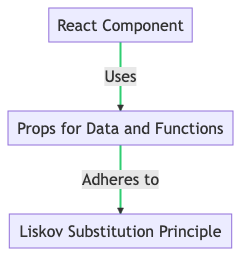Table of Contents
- Introduction
- Single Responsibility Principle (SRP)
- Open-Closed Principle (OCP)
- Liskov Substitution Principle (LSP)
- Interface Segregation Principle (ISP)
- Dependency Inversion Principle (DIP)
- Important Notes
- Conclusion
1. Introduction
The SOLID principles are a set of design guidelines for making software designs more understandable, flexible, and maintainable. They were introduced by Robert C. Martin and are universally accepted concepts in software engineering. Let's explore how these principles can be applied in React.
2. Single Responsibility Principle (SRP)
The Single Responsibility Principle states that a class or module should have only one reason to change. In the context of React, this means that a component should ideally do one thing only.
// Good
function UserName(props) {
return <h1>{props.name}</h1>;
}
// Bad
function User(props) {
return (
<div>
<h1>{props.name}</h1>
<button onClick={props.logout}>Logout</button>
</div>
);
}
In the above example, the `User` component is doing two things: displaying the user's name and handling the logout functionality. This violates the SRP. A better approach is to split this component into two: `UserName` and `LogoutButton`.
3. Open-Closed Principle (OCP)
The Open-Closed Principle states that software entities should be open for extension but closed for modification. In React, we can achieve this by using props to pass behavior into components.
// Good
function WelcomeMessage({ message }) {
return <h1>{message}</h1>;
}
// Usage
<WelcomeMessage message="Welcome to our website!" />
// Bad
function WelcomeMessage() {
const message = "Welcome to our website!";
return <h1>{message}</h1>;
}
In the bad example, if we want to change the welcome message, we have to modify the `WelcomeMessage` component. In the good example, we can simply pass a different message as a prop, adhering to the Open-Closed Principle.
4. Liskov Substitution Principle (LSP)
The Liskov Substitution Principle states that if a program is using a base class, it should be able to use any of its subclasses without the program knowing it. In React, this can be interpreted as using props to pass data and functions into a component, and not caring about the implementation details of these props.
function Button({ onClick, children }) {
return <button onClick={onClick}>{children}</button>;
}
// Usage
<Button onClick={() => console.log('Button clicked!')}>Click me!</Button>
In this example, the `Button` component doesn't care about what happens when it's clicked. It just knows that it needs to call the `onClick` function. This is an example of the Liskov Substitution Principle in action.
5. Interface Segregation Principle (ISP)
The Interface Segregation Principle states that no client should be forced to depend on interfaces they do not use. In the context of React, this means that a component should not have to receive more props than it actually needs.
// Good
function UserName({ name }) {
return <h1>{name}</h1>;
}
// Bad
function UserName({ name, age, email }) {
return <h1>{name}</h1>;
}
In the bad example, the `UserName` component is receiving more props than it needs, violating the Interface Segregation Principle. In the good example, it only receives the props it needs.
6. Dependency Inversion Principle (DIP)
The Dependency Inversion Principle states that high-level modules should not depend on low-level modules. Both should depend on abstractions. In React, this can be achieved by passing dependencies into components as props.
// Good
function UserList({ users }) {
return (
<ul>
{users.map(user => (
<li key={user.id}>{user.name}</li>
))}
</ul>
);
}
// Usage
<UserList users={users} />
// Bad
function UserList() {
const users = /* Fetch users from API */;
return (
<ul>
{users.map(user => (
<li key={user.id}>{user.name}</li>
))}
</ul>
);
}
In the bad example, the `UserList` component is directly dependent on the API to fetch users. In the good example, it receives the users as a prop, adhering to the Dependency Inversion Principle.
7. Important Notes
- SOLID principles are guidelines, not hard rules. It's okay to violate them if it makes sense for your specific use case.
- Applying SOLID principles can make your code more readable, maintainable, and testable.
- SOLID principles can be applied at different levels of abstraction, from low-level code to high-level architecture.
8. Conclusion
SOLID principles are a powerful tool for designing and maintaining large-scale applications. By understanding and applying these principles, we can write cleaner, more maintainable code in React. Happy coding!
![[ info ]](https://blogger.googleusercontent.com/img/b/R29vZ2xl/AVvXsEjvLLqADnAK9xPqLtqTQ6fPmxed7GEnIR73zosubICybujchccNTHrafmIMSAXrTEbdlchQvuLkgA2W8oy70RwbX3Re7kILy6g28-KfaNLWAK9OfkOCtOEbA23P3BAmMk0r1Sq0k_SLHGo/s1600/devinfo.png)







Pega Developer Course
ReplyDeleteBecome a certified Pega Developer by mastering app design, workflows, case management, and integrations. Get trained with real-world implementation projects and prepare for CSA/CSSA certifications.